The document discusses understanding protein function on a genome scale through the analysis of molecular networks. It highlights the complexities of mapping protein functions to genes and the challenges of integrating diverse data sources for constructing protein interaction networks. Additionally, it outlines various methodologies for predicting networks and the dynamics of these networks across different cellular states.
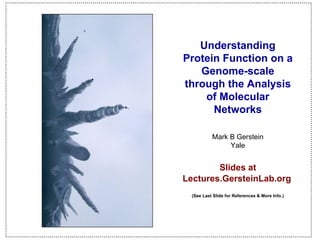
![The problem: Grappling with Function on a Genome Scale? 250 of ~530 originally characterized on chr. 22 [Dunham et al. Nature (1999)] >25K Proteins in Entire Human Genome (with alt. splicing) .…… ~530](https://image.slidesharecdn.com/cornell-pbsb-20090126-nets-090410132026-phpapp01/85/Cornell-Pbsb-20090126-Nets-2-320.jpg)


![Some obvious issues in scaling single molecule definition to a genomic scale Fundamental complexities Often >2 proteins/function Multi-functionality: 2 functions/protein Role Conflation: molecular, cellular, phenotypic Fun terms… but do they scale?.... Starry night (P Adler, ’94) [Seringhaus et al. GenomeBiology (2008)]](https://image.slidesharecdn.com/cornell-pbsb-20090126-nets-090410132026-phpapp01/85/Cornell-Pbsb-20090126-Nets-5-320.jpg)
![Hierarchies & DAGs of controlled-vocab terms but still have issues... [Seringhaus & Gerstein, Am. Sci. '08] GO (Ashburner et al.) MIPS (Mewes et al.)](https://image.slidesharecdn.com/cornell-pbsb-20090126-nets-090410132026-phpapp01/85/Cornell-Pbsb-20090126-Nets-6-320.jpg)
![Towards Developing Standardized Descriptions of Function Subjecting each gene to standardized expt. and cataloging effect KOs of each gene in a variety of std. conditions => phenotypes Std. binding expts for each gene (e.g. prot. chip) Function as a vector Interaction Vectors [Lan et al, IEEE 90:1848]](https://image.slidesharecdn.com/cornell-pbsb-20090126-nets-090410132026-phpapp01/85/Cornell-Pbsb-20090126-Nets-7-320.jpg)
![Networks (Old & New) [Seringhaus & Gerstein, Am. Sci. '08] Classical KEGG pathway Same Genes in High-throughput Network](https://image.slidesharecdn.com/cornell-pbsb-20090126-nets-090410132026-phpapp01/85/Cornell-Pbsb-20090126-Nets-8-320.jpg)
![Networks occupy a midway point in terms of level of understanding 1D: Complete Genetic Partslist ~2D: Bio-molecular Network Wiring Diagram 3D: Detailed structural understanding of cellular machinery [Jeong et al. Nature, 41:411] [Fleischmann et al., Science, 269 :496]](https://image.slidesharecdn.com/cornell-pbsb-20090126-nets-090410132026-phpapp01/85/Cornell-Pbsb-20090126-Nets-9-320.jpg)
![Networks as a universal language Disease Spread [Krebs] Protein Interactions [Barabasi] Social Network Food Web Neural Network [Cajal] Electronic Circuit Internet [Burch & Cheswick]](https://image.slidesharecdn.com/cornell-pbsb-20090126-nets-090410132026-phpapp01/85/Cornell-Pbsb-20090126-Nets-10-320.jpg)
![Networks as a Central Theme in Systems Biology Reductionist Approach Integrative Approach [Adapted from H Yu] Systems Biology](https://image.slidesharecdn.com/cornell-pbsb-20090126-nets-090410132026-phpapp01/85/Cornell-Pbsb-20090126-Nets-11-320.jpg)
![Interactome networks Network pathology & pharmacology [Adapted from H Yu] Breast Cancer Parkinson’s Disease Alzheimer’s Disease Multiple Sclerosis](https://image.slidesharecdn.com/cornell-pbsb-20090126-nets-090410132026-phpapp01/85/Cornell-Pbsb-20090126-Nets-12-320.jpg)
![Using the position in networks to describe function [NY Times, 2-Oct-05, 9-Dec-08]](https://image.slidesharecdn.com/cornell-pbsb-20090126-nets-090410132026-phpapp01/85/Cornell-Pbsb-20090126-Nets-13-320.jpg)
![Types of Networks Interaction networks [Horak, et al, Genes & Development, 16:3017-3033] [DeRisi, Iyer, and Brown, Science, 278:680-686] [Jeong et al, Nature, 41:411] Regulatory networks Metabolic networks Nodes: proteins or genes Edges: interactions](https://image.slidesharecdn.com/cornell-pbsb-20090126-nets-090410132026-phpapp01/85/Cornell-Pbsb-20090126-Nets-14-320.jpg)






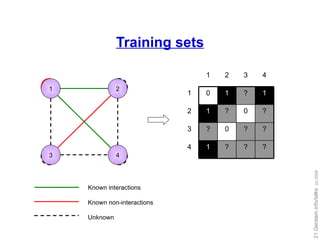









![Our work: training set expansion Goal: Utilize the flexibility of local modeling Tackle the problem of insufficient training data Idea: generate auxiliary training data Prediction propagation Kernel initialization [Yip and Gerstein, Bioinformatics ('09, in press)]](https://image.slidesharecdn.com/cornell-pbsb-20090126-nets-090410132026-phpapp01/85/Cornell-Pbsb-20090126-Nets-31-320.jpg)
![Prediction propagation Motivation: some objects have more examples than others Our approach: Learn models for objects with more examples first Propagate the most confident predictions as auxiliary examples of other objects [Yip and Gerstein, Bioinformatics ('09, in press)] 1 2 4 3 1 2 4 3 1 2 4 3 1 2 4 3 1 2 4 3](https://image.slidesharecdn.com/cornell-pbsb-20090126-nets-090410132026-phpapp01/85/Cornell-Pbsb-20090126-Nets-32-320.jpg)
![Kernel initialization Motivation: what if most objects have very few examples? Our approach (inspired by the direct method): Add the most similar pairs in the kernel as positive examples Add the most dissimilar pairs in the kernel as negative examples [Yip and Gerstein, Bioinformatics ('09, in press)] 1 2 4 3 1 2 3 4 1 1.00 0.57 0.55 0.40 2 0.57 1.00 0.66 0.89 3 0.55 0.66 1.00 0.79 4 0.40 0.89 0.79 1.00 1 2 4 3](https://image.slidesharecdn.com/cornell-pbsb-20090126-nets-090410132026-phpapp01/85/Cornell-Pbsb-20090126-Nets-33-320.jpg)
![Remarks Can be used in combination Prediction propagation theoretically related to co-training (Blum and Mitchell, 1998) Semi-supervised Similarity with PSI-BLAST Algorithm complexity O(nf(n)) of local modeling vs. O(f(n 2 )) of global modeling [Yip and Gerstein, Bioinformatics ('09, in press)]](https://image.slidesharecdn.com/cornell-pbsb-20090126-nets-090410132026-phpapp01/85/Cornell-Pbsb-20090126-Nets-34-320.jpg)
![Experiments Gold-standard interactions: BioGRID, from studies that report less than 10 interactions Features: [Yip and Gerstein, Bioinformatics ('09, in press)] Code Data type Source Kernel phy Phylogenetic profiles COG v7 (Tatusov et al., 1997) RBF ( =3,8) loc Sub-cellular localization (Huh et al., 2003) Linear exp-gasch Gene expression (environmental response) (Gasch et al., 2000) RBF ( =3,8) exp-spellman Gene expression (cell-cycle) (Spellman et al., 1998) RBF ( =3,8) y2h-ito Yeast two-hybrid (Ito et al., 2000) Diffusion ( =0.01) y2h-uetz Yeast two-hybrid (Uetz et al., 2000) Diffusion ( =0.01) tap-gavin Tandem affinity purification (Gavin et al., 2006) Diffusion ( =0.01) tap-krogan Tandem affinity purification (Krogan et al., 2006) Diffusion ( =0.01) int Integration Summation](https://image.slidesharecdn.com/cornell-pbsb-20090126-nets-090410132026-phpapp01/85/Cornell-Pbsb-20090126-Nets-35-320.jpg)
![Prediction accuracy Observations: Highest accuracy by training set expansion Overfitting of local modeling without training set expansion Comparing prediction propagation and kernel initialization [Yip and Gerstein, Bioinformatics ('09, in press)]](https://image.slidesharecdn.com/cornell-pbsb-20090126-nets-090410132026-phpapp01/85/Cornell-Pbsb-20090126-Nets-36-320.jpg)
![Complementarity of the two methods [Yip and Gerstein, Bioinformatics ('09, in press)]](https://image.slidesharecdn.com/cornell-pbsb-20090126-nets-090410132026-phpapp01/85/Cornell-Pbsb-20090126-Nets-37-320.jpg)

![Global topological measures Indicate the gross topological structure of the network Degree ( K ) Path length ( L ) Clustering coefficient ( C ) [Barabasi] Interaction and expression networks are undirected 5 2 1/6](https://image.slidesharecdn.com/cornell-pbsb-20090126-nets-090410132026-phpapp01/85/Cornell-Pbsb-20090126-Nets-39-320.jpg)

![Scale-free networks Hubs dictate the structure of the network log(Degree) log(Frequency) Power-law distribution [Barabasi]](https://image.slidesharecdn.com/cornell-pbsb-20090126-nets-090410132026-phpapp01/85/Cornell-Pbsb-20090126-Nets-41-320.jpg)
![Hubs tend to be Essential Essential Non- Essential Integrate gene essentiality data with protein interaction network. Perhaps hubs represent vulnerable points? [ Lauffenburger, Barabasi] "hubbiness" [Yu et al., 2003, TIG]](https://image.slidesharecdn.com/cornell-pbsb-20090126-nets-090410132026-phpapp01/85/Cornell-Pbsb-20090126-Nets-42-320.jpg)
![Relationships extends to "Marginal Essentiality" Essential Not important Marginal essentiality measures relative importance of each gene (e.g. in growth-rate and condition-specific essentiality experiments) and scales continuously with "hubbiness" important Very important "hubbiness" [Yu et al., 2003, TIG]](https://image.slidesharecdn.com/cornell-pbsb-20090126-nets-090410132026-phpapp01/85/Cornell-Pbsb-20090126-Nets-43-320.jpg)

![Gene expression data for five cellular conditions in yeast Multi-stage Binary [Brown, Botstein, Davis….] Cellular condition Cell cycle Sporulation Diauxic shift DNA damage Stress response](https://image.slidesharecdn.com/cornell-pbsb-20090126-nets-090410132026-phpapp01/85/Cornell-Pbsb-20090126-Nets-45-320.jpg)



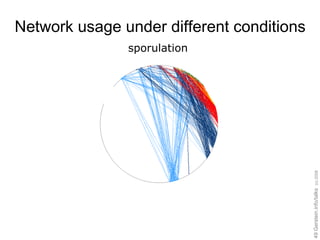

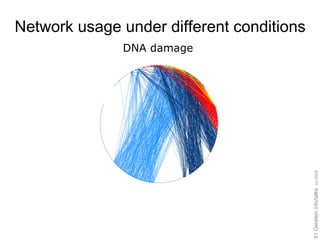

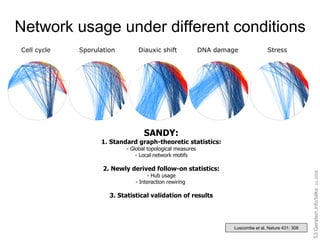


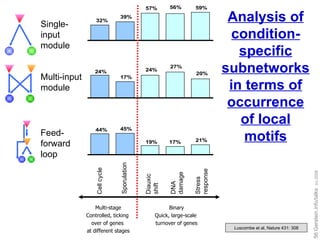










![Expressing data as matrices indexed by site, env. var., and pathway usage Pathway Sequences (Community Function) Environmental Features [Rusch et. al., (2007) PLOS Biology; Gianoulis et al., PNAS (in press, 2009]](https://image.slidesharecdn.com/cornell-pbsb-20090126-nets-090410132026-phpapp01/85/Cornell-Pbsb-20090126-Nets-67-320.jpg)
![Simple Relationships: Pairwise Correlations [ Gianoulis et al., PNAS (in press, 2009) ] Pathways](https://image.slidesharecdn.com/cornell-pbsb-20090126-nets-090410132026-phpapp01/85/Cornell-Pbsb-20090126-Nets-68-320.jpg)
![Canonical Correlation Analysis: Simultaneous weighting [ Gianoulis et al., PNAS (in press, 2009) ] + b’ + c’ GPI = a’ + b + c UPI = a](https://image.slidesharecdn.com/cornell-pbsb-20090126-nets-090410132026-phpapp01/85/Cornell-Pbsb-20090126-Nets-69-320.jpg)
![Canonical Correlation Analysis: Simultaneous weighting [ Gianoulis et al., PNAS (in press, 2009) ] + b’ + c’ GPI = a’ + b + c UPI = a Metabolic Pathways Environmental Features Temp Chlorophyll etc Photosynthesis Lipid Metabolism etc](https://image.slidesharecdn.com/cornell-pbsb-20090126-nets-090410132026-phpapp01/85/Cornell-Pbsb-20090126-Nets-70-320.jpg)
![Environmental-Metabolic Space The goal of this technique is to interpret cross-variance matrices We do this by defining a change of basis. [ Gianoulis et al., PNAS (in press, 2009) ] a,b](https://image.slidesharecdn.com/cornell-pbsb-20090126-nets-090410132026-phpapp01/85/Cornell-Pbsb-20090126-Nets-71-320.jpg)
![Circuit Map Environmentally invariant Environmentally variant Strength of Pathway co-variation with environment [ Gianoulis et al., PNAS (in press, 2009) ]](https://image.slidesharecdn.com/cornell-pbsb-20090126-nets-090410132026-phpapp01/85/Cornell-Pbsb-20090126-Nets-72-320.jpg)
![Conclusion #1: energy conversion strategy, temp and depth [ Gianoulis et al., PNAS (in press, 2009) ]](https://image.slidesharecdn.com/cornell-pbsb-20090126-nets-090410132026-phpapp01/85/Cornell-Pbsb-20090126-Nets-73-320.jpg)
![Conclusion #2: Outer Membrane components vary the environment [ Gianoulis et al., PNAS (in press, 2009) ]](https://image.slidesharecdn.com/cornell-pbsb-20090126-nets-090410132026-phpapp01/85/Cornell-Pbsb-20090126-Nets-74-320.jpg)
![Conclusion #3: Covariation of AA biosynthesis and Import Why is their fluctuation in amino acid metabolism? Is there a feature(s) that underlies those that are environmentally-variant as opposed to those which are not? [ Gianoulis et al., PNAS (in press, 2009) ]](https://image.slidesharecdn.com/cornell-pbsb-20090126-nets-090410132026-phpapp01/85/Cornell-Pbsb-20090126-Nets-75-320.jpg)
![Conclusion #4: Cofactor (Metal) Optimization Methionine degradation Polyamine biosynthesis Spermidine/Putrescine transporters Methionine synthesis Cobalamin biosynthesis Cobalt transporters Methionine Salvage IS DEPENDENT-ON Methionine IS NEEDED FOR S-adenosyl Methionine Biosynthesis (synthesize SAM one of the most important methyl donors) RELIES ON Arg/His/Ornithine transporters Methionine salvage, synthesis, and uptake, transport [ Gianoulis et al., PNAS (in press, 2009) ]](https://image.slidesharecdn.com/cornell-pbsb-20090126-nets-090410132026-phpapp01/85/Cornell-Pbsb-20090126-Nets-76-320.jpg)
![Biosensors: Beyond Canaries in a Coal Mine [ Gianoulis et al., PNAS (in press, 2009) ]](https://image.slidesharecdn.com/cornell-pbsb-20090126-nets-090410132026-phpapp01/85/Cornell-Pbsb-20090126-Nets-77-320.jpg)
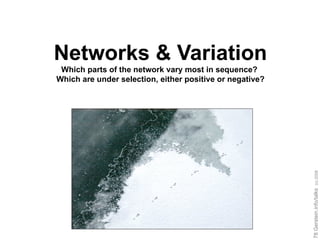





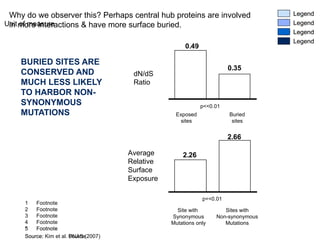


![SOME, BUT NOT ALL OF THE SINGLE-BASEPAIR SELECTION AT THE PERIPHERY IS DUE TO RELAXED CONSTRAINT There is a difference in variability (in terms of SNPs) between the network periphery and the center However, this difference is much smaller than the difference in selection This most likely means, that part of the effect we’re seeing is due to relaxed constraint (and higher variability) But, not the entire effect* Inter vs. Intra-Species Variation in Networks Reasoning * But it’s hard to quantify Source: Kim et al. (2007) PNAS Inter-Species (Fixed differences) Intra-Species (SNPs) [ Variability ]](https://image.slidesharecdn.com/cornell-pbsb-20090126-nets-090410132026-phpapp01/85/Cornell-Pbsb-20090126-Nets-87-320.jpg)
![Similar Results for Large-scale Genomic Changes (CNVs and SDs) There a small difference in variability (in terms of CNVs) between the network periphery and the center But, there is a (as shown before) marked difference in fixed (and hence, presumably, selected) SDs at the network periphery and center Inter vs. Intra-Species Variation in Networks Reasoning Source: Kim et al. (2007) PNAS Inter-Species (SDs) Intra-Species (CNVs) [ Variability ]](https://image.slidesharecdn.com/cornell-pbsb-20090126-nets-090410132026-phpapp01/85/Cornell-Pbsb-20090126-Nets-88-320.jpg)



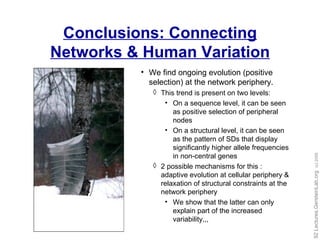
![TopNet – an automated web tool [Yu et al., NAR (2004); Yip et al. Bioinfo. (2006); Similar tools include Cytoscape.org, Idekar, Sander et al] (vers. 2 : " TopNet -like Yale Network Analyzer") Normal website + Downloaded code (JAVA) + Web service (SOAP) with Cytoscape plugin](https://image.slidesharecdn.com/cornell-pbsb-20090126-nets-090410132026-phpapp01/85/Cornell-Pbsb-20090126-Nets-93-320.jpg)





![DPM: Discriminative Partition Matching Cluster (Partition) Test Environment Metabolism Taurine biosynthesis Heme biosynthesis Asparagine degradation Nitrogen fixation Acylglycerol degradation Asparagine biosynthesis Cysteine Metabolism pval Functional class [ Gianoulis et al., PNAS (in press, 2009) ] InfoStorage & Processing .07 Cellular Process .08 Metabolism 4x10-14](https://image.slidesharecdn.com/cornell-pbsb-20090126-nets-090410132026-phpapp01/85/Cornell-Pbsb-20090126-Nets-99-320.jpg)
![Interactome [From H Yu] protein-DNA interactions protein-protein interactions PROTEOME GENOME Citrate Cycle METABOLISM Protein-small molecule interactions](https://image.slidesharecdn.com/cornell-pbsb-20090126-nets-090410132026-phpapp01/85/Cornell-Pbsb-20090126-Nets-100-320.jpg)
![Networks help us understand biological processes [From H Yu]](https://image.slidesharecdn.com/cornell-pbsb-20090126-nets-090410132026-phpapp01/85/Cornell-Pbsb-20090126-Nets-101-320.jpg)
![More Information on this Talk TITLE : Understanding Protein Function on a Genome-scale through the Analysis of Molecular Networks SUBJECT: Networks DESCRIPTION : Cornell Medical School, Physiology, Biophysics and Systems Biology (PBSB) graduate program, 2009.01.26, 16:00-17:00; [I: CORNELL-PBSB ] (Long networks talk, incl. the following topics: why networks w. amsci*, funnygene*, net. prediction intro, memint*, tse*, essen*, sandy*, metagenomics*, netpossel*, tyna*+ topnet*, & pubnet* . Fits easily into 60’ w. 10’ questions. PPT works on mac & PC and has many photos w. EXIF tag kwcornellpbsb .) (Paper references in the talk were mostly from Papers.GersteinLab.org. The above topic list can be easily cross-referenced against this website. Each topic abbrev. which is starred is actually a papers “ID” on the site. For instance, the topic pubnet * can be looked up at http://papers.gersteinlab.org/papers/ pubnet ) PERMISSIONS : This Presentation is copyright Mark Gerstein, Yale University, 2008. Please read permissions statement at http://www.gersteinlab.org/misc/permissions.html . Feel free to use images in the talk with PROPER acknowledgement (via citation to relevant papers or link to gersteinlab.org). . PHOTOS & IMAGES . For thoughts on the source and permissions of many of the photos and clipped images in this presentation see http://streams.gerstein.info . In particular, many of the images have particular EXIF tags, such as kwpotppt , that can be easily queried from flickr, viz: http://www.flickr.com/photos/mbgmbg/tags/ kwpotppt .](https://image.slidesharecdn.com/cornell-pbsb-20090126-nets-090410132026-phpapp01/85/Cornell-Pbsb-20090126-Nets-102-320.jpg)